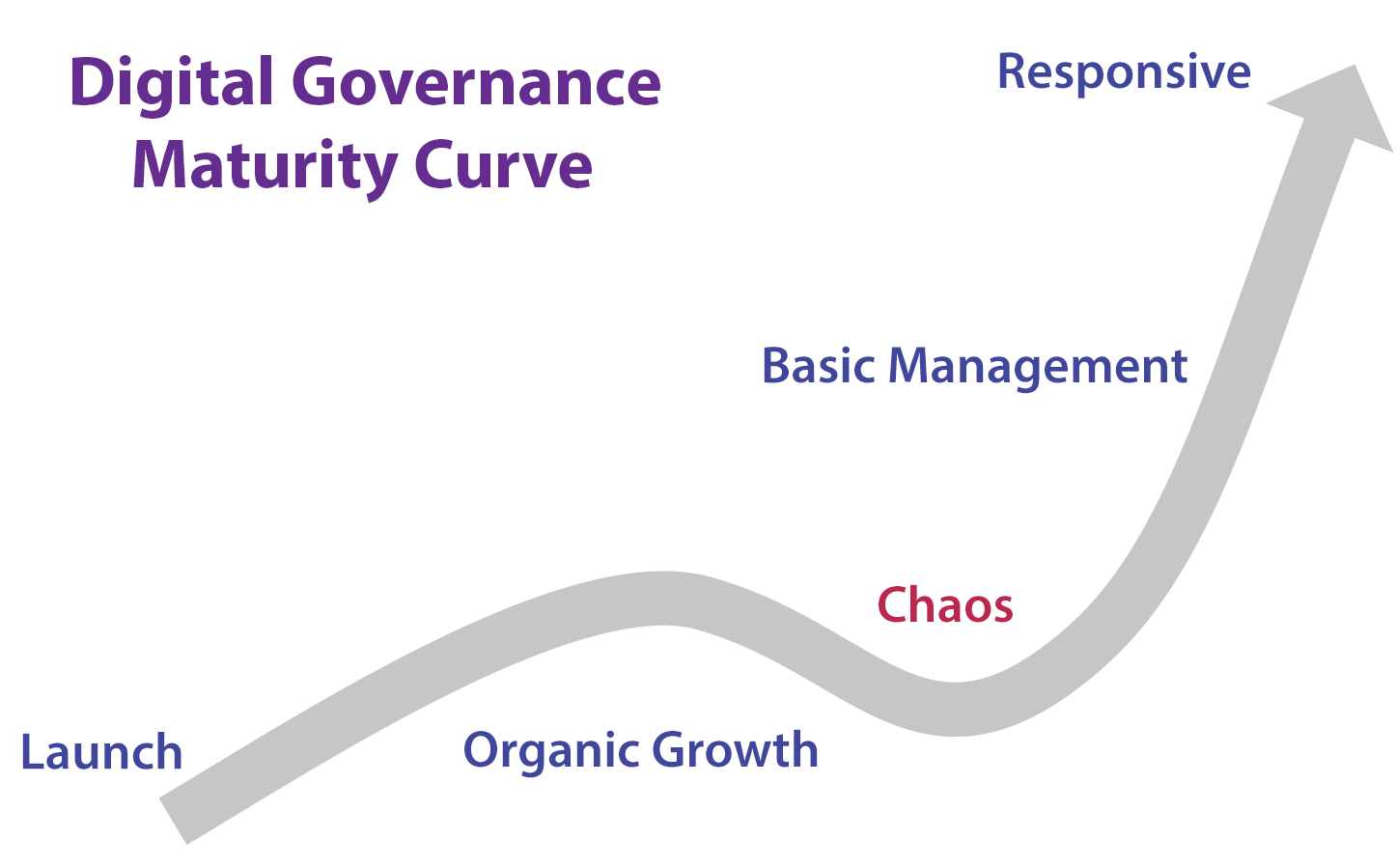Understanding Digital Governance Maturity

There is a digital governance maturity curve that most organizations move through when they launch a digital channel (Web, mobile, or social). The process of maturity begins with the decision to launch a new channel, and it culminates with the organization having fully integrated that channel into the company to the extent that governing dynamics and operational processes are automatic, leaving the organization fully responsive to digital trends.
The dynamics of each phase are fairly distinct. Most organizations that are seeking to improve digital governance are usually in the “chaos” phase, while some are stalled at “basic management” and trying to move to the next level. Also, organizations are typically at different places on this curve, depending on which digital channel is being considered. For example, an organization might be at “basic management” for websites, but at “launch” for its mobile channel, while in “chaos” for social channels. This issue can add complexity when designing a digital governance framework.
Maturity Stages and Dynamics
Launch
- Research and development mode, as the digital functionality or channel is being informally tested or formally piloted.
- Basic policy constraints are considered to ensure that the organization is operating within the bounds of the law and any other regulatory constraints.
- There are few standards imposed at this point because the organization is just going to “try out” new functionality to see if there is value to the organization.
Organic Growth
- Aspects of functionality “work.” Others in the organization begin to leverage the work of the piloting team.
- Functional and systemic redundancy begins (design, technology, process).
- Some progressive executives may understand the value of the channel, but deep value and mature business measurement tactics are not being applied.
- Functionality is thought of as a “cost center,” not a core revenue generator.
- Basic policy constraints are still in place, and some may be documented.
- There are usually few standards in place. Considerations around basic corporate standards, such as branding, begin to arise.
Chaos
- Executives and senior management are aware of the digital channel, but they have likely wholly delegated the creation of digital strategy to junior resources.
- Different organizational departments have created organizationally incongruent digital strategies. Competition for “ownership” begins to emerge.
- The organization is unable to identify and account for all its digital assets or the people who execute on and fund digital development inside the organization.
- Core marketing communications and IT policy are beginning to be formalized—sometimes separate from the stewardship and influence of the corporate legal team.
- Some standards are documented, but many core digital standards are missing.
Basic Management
- Executives and senior digital experts have begun a dialogue regarding the strategy for digital.
- The organization begins to consider its digital budget.
- Digital quality measurement tactics, systems, and software are emplaced.
- Some design, functionality, and platform normalization has begun, and efforts are made to reduce redundancies where they exist and where it is effective.
- A core digital center of excellence is beginning to emerge, although it may not have all of the desired authority.
- Performance is evaluated by examining tactical analytics like website “page hits” and number of “likes” in social media channels.
- The existence of a set of digital policies and standards is in place.
- Basic cross-organization collaboration teams begin to appear, such as “Web Councils” and standards development teams.
Responsive
- “Digital” is fully integrated within the organization and is no longer a functional silo.
- The digital team is clearly identified, organized, and funded.
- Accountability for digital strategy is clearly placed.
- A guiding principle for digital development is established.
- Performance indicators are defined, and mechanisms and programs for quality and success measurements are in place.
- Digital policy stewards and policy authors are identified.
- The process for external and internal policy review is in place.
- Digital standards steward(s) and authors are identified, and standards compliance and measurement mechanisms are implemented.
From Lisa Welchman, “The Basics of Digital Governance” in Managing Chaos: Digital Governance by Design (New York: Rosenfield Media, 2015), 25-27.





